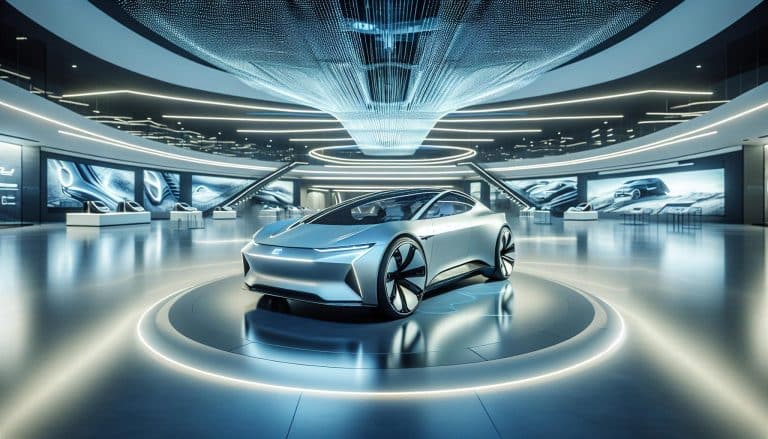Unveiling Elon Musk’s Multi-Billion Dollar Portfolio
Ever wonder what it’s like to walk a mile in Elon Musk’s shoes? Or rather, invest a million in his portfolio? As one of the most influential entrepreneurs of the 21st century, Musk’s investment strategies are as unique and innovative as the man himself.
From SpaceX to Tesla, his portfolio is a fascinating blend of cutting-edge technology and high-risk, high-reward ventures. It’s not just about making money, it’s about pushing the boundaries of what’s possible.
So buckle up. We’re about to take a deep dive into the world of Elon Musk’s investments, and who knows? You might even pick up a few tips for your own portfolio along the way.
Key Takeaways
- Elon Musk’s unique investment portfolio spans across multiple disruptive industries including electric vehicles, aerospace, artificial intelligence, tunnel construction, infrastructure, and cryptocurrencies, illustrating the power of diversification.
- Musk’s high-risk high-reward approach is a significant part of his investing strategy. This calculated risk assessment has been key to his portfolio’s success, with successful investments such as Tesla and SpaceX seriously boosting his net worth.
- Tesla plays a critical role in Elon Musk’s portfolio, significantly contributing to its success. With Musk being the largest shareholder, Tesla’s soaring value marked a colossal rise in Musk’s wealth. The sustained success of Tesla has also reinforced investor trust in Musk’s other ventures.
- SpaceX’s role in Musk’s portfolio reinforces diversification with a strong return on investments and acts as a buffer against risks tied to a single industry’s performance. Its upcoming projects signify future growth potential.
- SolarCity, now part of Tesla, contributes to Musk’s larger vision for sustainable energy. Despite past financial challenges, it holds potential for future innovations and improvements aligned with Musk’s net-zero emissions dream.
- Other notable holdings such as Neuralink, The Boring Company, and Bitcoin reflect Musk’s unconventional approach to investments and his readiness to explore high-risk avenues. This testifies to his unwavering spirit of innovation and disruption.
- The balance in Musk’s portfolio stems from a strategic mix of high-risk and steady assets, with Tesla offering stability amid the volatility of other holdings. To ensure portfolio growth and sustainability, Musk employs two key principles—diversity across industries and investments with long-term growth potential.
Overview of Elon Musk Portfolio
Elon Musk, renowned visionary and business tycoon, holds an eclectic and unique portfolio. It spans various industries, from revolutionary electric vehicles to groundbreaking aerospace technology.
The Power of Diversification in Musk’s Portfolio
Uncover the strength embedded in diversification, ensuring an evident aspect in Musk’s financial strategy. Placing his eggs into multiple baskets, he mitigated risks associated with heavy investment. For Musk, the investment isn’t simply in individual companies, but entire industries.
For example, Tesla, his electric vehicle and clean energy company, disrupts the automotive and energy sectors. SpaceX, on the other hand, pioneers in the commercial space industry. Interestingly, Musk also clocked investments in realms like artificial intelligence (AI) with his stake in OpenAI and Neuralink. Additionally, his most unconventional asset yet emerged with the founding of The Boring Company, a tunnel construction and infrastructure company that aspires to alleviate traffic congestion.
Risks and Rewards Assessment in Elon Musk’s Portfolio
When assessing Musk’s portfolio, it’s apparent that a significant part of his investing strategy revolves around understanding the risks and potential rewards. His investments tend to be high-risk, high-reward, pushing technological boundaries.
Taking SpaceX as an instance, his daring step to privatize space travel rested on unchartered territories, undoubtedly a risky venture. Yet, the success of SpaceX determined much of Musk’s net worth, rendering the unprecedented risk worthwhile. The company’s recent valuation surpassed $100 billion, signifying a high reward proposition.
To put it into perspective, Musk’s investment in Bitcoin also posed significant risk given the cryptocurrency’s volatility. Yet, if Musk’s prediction of future gains holds, it becomes another high-reward opportunity. It is these calculated risks that form the core of Musk’s assessment strategy and continue to underpin his portfolio’s success.
In Musk’s portfolio, it’s clear that each asset plays a strategic role. Whether by diversification or risk assessment, Musk’s investments divulge an intriguing insight: investing extends beyond mere wealth creation. It remains a vehicle for realizing a vision, challenging norms, and in Musk’s case, pushing humanity forward.
The Tesla Component in Elon Musk Portfolio

Tesla’s role in Elon Musk’s portfolio is paramount. It exemplifies his commitment to technological innovation and futuristic vision.
Financial Performance of Tesla
Tesla’s financial performance has substantially swayed Musk’s overall portfolio’s success. For instance, Tesla’s share price rocketed more than 700% in 2020. It translated into monumental profits for Musk. Additionally, as of 2021 Q3, Tesla reported a record $1.62 billion in net income, showcasing the company’s financial might.
Exciting facts percolate further, painting Tesla’s financial picture more vividly. Musk owns approximately 20% of Tesla’s shares, making him the company’s largest shareholder. With Tesla’s market capitalization crossing the $1 trillion mark in October 2021, Musk’s substantial stake acquires significant value, highly impacting his portfolio.
Impact of Tesla on the Portfolio’s Success
The dominance of Tesla in Musk’s portfolio is unarguable. Tesla’s soaring value played a key role in Musk becoming the world’s richest man in January 2021. His wealth, majorly represented by his Tesla holdings, continued to inflate with Tesla’s colossal market performance.
The growing success of Tesla has had a butterfly effect, favorably impacting Musk’s other ventures. Tesla’s success story fortified investors’ trust in Musk’s capabilities, leading to increased investments in his other innovative ideas like SpaceX, Neuralink, and Boring Company.
In essence, Tesla’s illustrious journey and its robust financial performance amplified the value of Elon Musk’s portfolio, asserting the substantial impact of Tesla on his portfolio’s success.
The SpaceX Factor in Elon Musk Portfolio
Delving into one of the prime ventures in Elon Musk’s portfolio, SpaceX, we’ll spotlight the valuation, future prospects, and its overall role within this diverse investment framework.
Valuation and Future Prospects of SpaceX
SpaceX, formally known as Space Exploration Technologies Corp., constructs a significant portion of Elon Musk’s portfolio. Founded in 2002, SpaceX plays a seminal role in privatizing space travel and has contributed magnificently towards Musk’s escalating fortune.
Sitting within the portfolio, SpaceX has an estimated worth of about $74 billion as of August 2021, having grown immensely from its $46 billion valuation in August 2020. This growth is representative of Musk’s knack for picking industry disruptors, which continue to yield exponential results.
Talk of future prospects elicits excitement. SpaceX continues to pioneer advancements in space exploration with plans to colonize Mars, establish satellite internet coverage (Starlink), and implement a more efficient means of global travel – projects that pose significant growth potential. Thus, holding substantial shares in SpaceX reaffirms Musk’s continued ascendency in net worth rankings.
Role of SpaceX in the Portfolio’s Diversification
Diversification operates as a central tenet in the investment strategy of Musk. Captivating as Tesla may be, SpaceX is similarly influential in balancing and diversifying Musk’s portfolio. The company’s work on revolutionary projects denotes a category of its own, distinct from Tesla’s electric vehicle and sustainability focus.
SpaceX’s undertakings, including manned space flights and deployment of internet satellites, indicate future avenues for revenue creation. With this, SpaceX broadens the base of Musk’s portfolio, countering the automotive and artificial intelligence sectors where Tesla and Neurolink operate.
In essence, SpaceX serves a dual purpose in Musk’s portfolio. It stands as a strong performer in terms of return on investment, while also providing a buffer through sector diversification. Consequently, it mitigates potential risks tied to the performance of a single industry.
In aggregating his wealth and tuning his portfolio, Elon Musk demonstrates a masterclass in strategic diversification and industry prediction. SpaceX illuminates this, highlighting its integral role, potential future gains, and robust contribution to portfolio diversification.
The SolarCity Element in Elon Musk Portfolio
In Elon Musk’s diversified portfolio, SolarCity has made its mark as one of the key elements in pushing for clean energy initiatives. This section sheds light on SolarCity’s market performance and its contribution to Musk’s clean energy investments.
Evaluation of SolarCity’s Market Performance
SolarCity, founded in 2006 by two of Musk’s cousins with Musk himself as chairman, quickly grew to become America’s largest residential solar installer. The company’s shares had a steep escalation after its initial public offering (IPO) in 2012. At the IPO, shares were valued at $8 apiece, instantly shooting up over 47% in the first day of trading. On March 10, 2014, the shares peaked at $86.14, marking a significant appreciation in value. However, this favourable tiding didn’t last long as SolarCity struggled with mounting debts and decreasing government subsidies for solar power. The company’s share value started dipping and continued on a downward slope until it was eventually bought by Tesla in 2016 for $2.6 billion.
That’s not all, SolarCity’s integration into Tesla hasn’t been without its challenges. Although the motive behind acquiring SolarCity was to closely align it with Tesla’s clean energy mission, it saddled Tesla with SolarCity’s debt and slowed down the company’s profitability.
However, it’s important to note, Tesla’s continued investment in solar energy solutions and the production of solar roofs points to a potential reclamation of their lost market dominance in the future. In the third quarter of 2020, Tesla reported to have tripled its solar installations as compared to the previous year.
Contribution of SolarCity to Musk’s Clean Energy Investments
As a part of Musk’s portfolio, SolarCity has made substantial contributions to Musk’s clean energy investments. The acquisition helped Tesla in its quest to provide end-to-end energy solutions, integrating solar energy generation with Tesla’s storage solutions. The vision was to offer products that are environmentally friendly, from electric cars to solar homes, resulting in a comprehensive energy solution and contributing to the overall reduction of carbon footprints.
SolarCity, despite its troughs, paved the way for Tesla’s solar ambitions. Offering patterns for further innovations and improvements, it played a significant part shaping Musk’s net-zero emissions dream into reality. Meaning, SolarCity does not just reflect an investment choice, but rather aligns with Musk’s vision for a sustainable future.
Solar energy investments, with SolarCity at the helm, aren’t just financial pursuits. They embody Musk’s belief in combating climate change and his commitment to making Earth an interplanetary species’ ecological home.
Other Significant Holdings in Elon Musk Portfolio
In addition to his reign in the electric vehicle, aerospace, and clean energy sectors, Elon Musk’s portfolio includes intriguing and equally disruptive endeavors like Neuralink and The Boring Company. Additionally, his audacious plunge into the cryptocurrencies domain signifies another dimension of risk-taking and innovative approach.
Neuralink and The Boring Company’s Influence
Neuralink, a neurotechnology firm aimed at integrating AI with the human brain, constitutes a significant part of Musk’s array of holdings. Neuralink’s vision carries Musk’s broader ambitions of ensuring the symbiotic existence of humans with artificial intelligence, revealing his deep commitment to AI as a tool for societal progress.
The Boring Company, on the other hand, symbolizes Musk’s persistent drive to redefine infrastructure development. With a focus on developing underground tunnel networks for autonomous electric vehicles, The Boring Company resonates his broader vision of sustainable, efficient transportation solutions. Despite being a relatively younger player in Musk’s portfolio, it manifests his persistent efforts towards reimagining urban commute, underscoring his commitment to eco-conscious innovations.
Bitcoin and Other Cryptocurrencies in the Portfolio
Musk’s foray into cryptocurrencies, particularly Bitcoin, demonstrates another significant facet of his investment preferences. In February 2021, Tesla invested $1.5 billion in Bitcoin, signalling Musk’s conviction in cryptocurrencies as a viable financial tool. Despite facing criticism and considerable market volatility, Musk stands by his company’s investments in Bitcoin, asserting cryptocurrencies’ potential in transforming the financial landscape.
Though prone to controversies, Musk’s interactions with other cryptocurrencies—Dogecoin, for instance—exemplify a risk-taking mindset and a willingness to explore unconventional territories. Even though these ventures contribute a relatively smaller percentage to Musk’s portfolio, they indisputably testify to his unwavering spirit of innovation and disruption.
How Elon Musk Balances His Portfolio
Balancing a portfolio exemplifies calculated strategy and foresight, especially if your name is Elon Musk. Diversified across high-growth industries, Musk’s astutely balanced portfolio is a testament to his acumen, sparking interest and envy in equal measure.
The Interplay of High-Risk vs. Stable Assets
In Musk’s well-balanced portfolio, there’s a dynamic interplay between high-risk and stable assets. High-risk assets, such as SpaceX, Neuralink, and cryptocurrency, outline his appetite for disruptive innovation and elevated returns. Despite the associated risks, these ventures generate lucrative returns and milestones in technological advancements.
Musk balances these high-risk investments with stable assets. As an example, Tesla’s growth of 700% in 2020 offered stability amid the volatility of other portfolio entities. This stability, integral to the performance and resilience of Musk’s portfolio, is key in optimizing return potential while minimizing associated risk.
Strategies Employed for Portfolio Growth and Sustainability
To ensure portfolio growth and sustainability, Musk relies largely on two principles – diversification and long-term growth potential. Diversification entails a mix of entities across various industries, from electric vehicles to space travel, neurotechnology, and sustainability solutions. It’s this diversification that fosters resilience, buffering the portfolio against financial shocks and industry-specific risks.
In terms of long-term growth potential, Musk invests in ambitious, world-changing ideas. Though they may pose significant initial risks, his projects exhibit the potential for substantial gains over time. SpaceX and Tesla, being prime instances, are transforming their respective sectors and continuing to add value to Musk’s portfolio.
Investments in emerging technologies – be it AI through Neuralink, underground transportation solutions through The Boring Company, or digital currencies like Bitcoin – indicate Musk’s strategic approach to staying ahead of the curve. He ensures constant portfolio growth by continuing to innovate, disrupt, and redefine the possibilities within the technology and transportation domains.
Conclusion
You’ve journeyed through the dynamic world of Elon Musk’s investments. His portfolio, a testament to his innovative spirit, spans across diverse sectors. From the electric buzz of Tesla to the final frontier with SpaceX, Musk’s ventures have revolutionized industries. His clean energy focus, evident in the incorporation of SolarCity into Tesla, underscores his commitment to sustainable solutions.
Ventures like Neuralink and The Boring Company further reflect Musk’s foresight, showcasing his belief in AI and eco-friendly transportation. His foray into cryptocurrencies, a risky yet innovative move, speaks volumes about his investment mindset.
Musk’s portfolio management strategy, balancing high-risk and stable assets, is a masterclass in maintaining growth and sustainability. His emphasis on diversification and investment in emerging technologies is a blueprint for future success. As you reflect on Musk’s portfolio, consider how his strategic approach could influence your own investment decisions.
What is Elon Musk’s investment strategy?
Elon Musk employs a diversified approach to investing, spreading his assets across various sectors including electric vehicles, aerospace, and AI. He balances high-risk and stable assets to drive innovation and manage risks.
Which are some of Musk’s successful ventures?
Musk’s most notable successes are Tesla and SpaceX. Amidst Tesla’s triumph in the electric vehicle industry, Musk earned the title of the world’s wealthiest individual in 2021.
What is the significance of SolarCity in Musk’s portfolio?
SolarCity, integrated into Tesla, marks Musk’s commitment to clean energy investments.
What do Neuralink and The Boring Company represent in Musk’s portfolio?
Neuralink and The Boring Company are representative of Musk’s interests in AI and eco-conscious transportation solutions, both significant holdings in his portfolio.
Is Elon Musk involved in cryptocurrencies?
Yes, Musk has shown an interest in cryptocurrencies, especially Bitcoin and Dogecoin. This interest exemplifies Musk’s innovative mindset and willingness to embrace risk.
How does Musk balance his portfolio?
Musk strikes a balance in his portfolio by diversifying across industries and investing in emerging technologies. This strategy ensures long-term growth potential and innovations.








 Bitcoin
Bitcoin  Ethereum
Ethereum  Tether
Tether  XRP
XRP  USDC
USDC  Solana
Solana  TRON
TRON  Lido Staked Ether
Lido Staked Ether  Dogecoin
Dogecoin  Figure Heloc
Figure Heloc  Cardano
Cardano  WhiteBIT Coin
WhiteBIT Coin  Wrapped stETH
Wrapped stETH  Bitcoin Cash
Bitcoin Cash  Wrapped Bitcoin
Wrapped Bitcoin  USDS
USDS  Wrapped eETH
Wrapped eETH  Binance Bridged USDT (BNB Smart Chain)
Binance Bridged USDT (BNB Smart Chain)  Chainlink
Chainlink  Monero
Monero  WETH
WETH  LEO Token
LEO Token  Zcash
Zcash  Stellar
Stellar  Hyperliquid
Hyperliquid  Coinbase Wrapped BTC
Coinbase Wrapped BTC  Ethena USDe
Ethena USDe  Litecoin
Litecoin  Sui
Sui  Avalanche
Avalanche  Hedera
Hedera  sUSDS
sUSDS  USDT0
USDT0  Shiba Inu
Shiba Inu  Dai
Dai  Uniswap
Uniswap  PayPal USD
PayPal USD  Mantle
Mantle  Cronos
Cronos  World Liberty Financial
World Liberty Financial  Toncoin
Toncoin  Ethena Staked USDe
Ethena Staked USDe  Canton
Canton  Polkadot
Polkadot  USD1
USD1  Rain
Rain  Aave
Aave  MemeCore
MemeCore